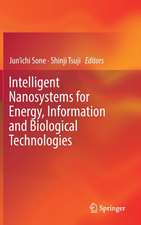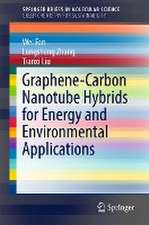Carbon Nanotube and Graphene Nanoribbon Interconnects
Autor Debaprasad Das, Hafizur Rahamanen Limba Engleză Hardback – 16 dec 2014
With an increase in demand for more circuit components on a single chip, there is a growing need for nanoelectronic devices and their interconnects (a physical connecting medium made of thin metal films between several electrical nodes in a semiconducting chip that transmit signals from one point to another without any distortion). Carbon Nanotube and Graphene Nanoribbon Interconnects explores two new important carbon nanomaterials, carbon nanotube (CNT) and graphene nanoribbon (GNR), and compares them with that of copper-based interconnects. These nanomaterials show almost 1,000 times more current-carrying capacity and significantly higher mean free path than copper. Due to their remarkable properties, CNT and GNR could soon replace traditional copper interconnects. Dedicated to proving their benefits, this book covers the basic theory of CNT and GNR, and provides a comprehensive analysis of the CNT- and GNR-based VLSI interconnects at nanometric dimensions.
Explore the Potential Applications of CNT and Graphene for VLSI Circuits
The book starts off with a brief introduction of carbon nanomaterials, discusses the latest research, and details the modeling and analysis of CNT and GNR interconnects. It also describes the electrical, thermal, and mechanical properties, and structural behavior of these materials. In addition, it chronicles the progression of these fundamental properties, explores possible engineering applications and growth technologies, and considers applications for CNT and GNR apart from their use in VLSI circuits.
Comprising eight chapters this text:
- Covers the basics of carbon nanotube and graphene nanoribbon
- Discusses the growth and characterization of carbon nanotube and graphene nanoribbon
- Presents the modeling of CNT and GNR as future VLSI interconnects
- Examines the applicability of CNT and GNR in terms of several analysis works
- Addresses the timing and frequency response of the CNT and GNR interconnects
- Explores the signal integrity analysis for CNT and GNR interconnects
- Models and analyzes the applicability of CNT and GNR as power interconnects
- Considers the future scope of CNT and GNR
| Toate formatele și edițiile | Preț | Express |
|---|---|---|
| Paperback (1) | 427.84 lei 6-8 săpt. | |
| CRC Press – 15 noi 2017 | 427.84 lei 6-8 săpt. | |
| Hardback (1) | 1097.57 lei 6-8 săpt. | |
| CRC Press – 16 dec 2014 | 1097.57 lei 6-8 săpt. |
Preț: 1097.57 lei
Preț vechi: 1554.60 lei
-29% Nou
Puncte Express: 1646
Preț estimativ în valută:
210.05€ • 218.48$ • 173.41£
210.05€ • 218.48$ • 173.41£
Carte tipărită la comandă
Livrare economică 12-26 aprilie
Preluare comenzi: 021 569.72.76
Specificații
ISBN-13: 9781482239485
ISBN-10: 1482239485
Pagini: 196
Ilustrații: 128
Dimensiuni: 156 x 234 mm
Greutate: 0.42 kg
Ediția:1
Editura: CRC Press
Colecția CRC Press
ISBN-10: 1482239485
Pagini: 196
Ilustrații: 128
Dimensiuni: 156 x 234 mm
Greutate: 0.42 kg
Ediția:1
Editura: CRC Press
Colecția CRC Press
Cuprins
Introduction to Allotropes of Carbon Nanomaterials. Growth of Carbon Nanotubes and Graphene Nanoribbon. Modeling of CNT and GNR Interconnects. Timing Analysis in CNT Interconnects. RF and Stability Analyses in CNT and GNR Interconnects. Signal Integrity in CNT and GNR Interconnects. Applicability of CNT and GNR as Power Interconnects. Future Applications of CNT and GNR. References. Index.
Notă biografică
Dr. Debaprasad Das received a bachelor’s (honors) degree in physics in 1995, a bachelor’s degree in radio physics and electronics in 1998, a master’s degree in electronics and telecommunication engineering in 2006, and a PhD in engineering in 2013 from the Vidyasagar University, University of Calcutta, Jadavpur University, and Bengal Engineering and Science University, Shibpur, respectively. Presently, he is working as an associate professor and head in the Department of Electronics and Telecommunication Engineering, Assam University, Silchar, India. He has authored or coauthored several research papers in national and international journals and conferences, and authored four books.
Dr. Hafizur Rahaman received a bachelor’s degree in electrical engineering from Bengal Engineering College, India, in 1986, and a master’s degree in electrical engineering and a PhD in computer science and engineering from Jadavpur University, Kolkata, India, in 1988 and 2003, respectively. He is a full professor of the Indian Institute of Engineering Science and Technology, Shibpur, West Bengal, India. His research interests include VLSI design and test, CAD for micro-fluidic biochips, emerging nanotechnologies, and reversible computing. He has published more than 280 research articles in archival journals and refereed conference proceedings.
Dr. Hafizur Rahaman received a bachelor’s degree in electrical engineering from Bengal Engineering College, India, in 1986, and a master’s degree in electrical engineering and a PhD in computer science and engineering from Jadavpur University, Kolkata, India, in 1988 and 2003, respectively. He is a full professor of the Indian Institute of Engineering Science and Technology, Shibpur, West Bengal, India. His research interests include VLSI design and test, CAD for micro-fluidic biochips, emerging nanotechnologies, and reversible computing. He has published more than 280 research articles in archival journals and refereed conference proceedings.
Recenzii
"The book, Caron Nanotube and Graphene Nanoribbon Interconnects, authored by Drs. Debapraad Das and Hafizur Rahaman serves as a good source of material on CNT and GNR interconnects for readers who wish to get into this area and also for practicing engineers who would like to be updated in advances of this field."
—Prof. Ashok Srivastava, Louisiana State University, Baton Rouge, USA
"Mathematical analysis included in each and every chapter is the main strength of the materials. ... The book is very precise and useful for those who are working in this area. ... highly focused, very compact, and easy to apply. ... This book depicts a detailed analysis and modelling of carbon nanotube and graphene nanoribbon interconnects. The book also covers the electrical circuit modelling of carbon nanotubes and graphene nanoribbons."
—Prof. Chandan Kumar Sarkar, Jadavpur University, Kolkata, India
—Prof. Ashok Srivastava, Louisiana State University, Baton Rouge, USA
"Mathematical analysis included in each and every chapter is the main strength of the materials. ... The book is very precise and useful for those who are working in this area. ... highly focused, very compact, and easy to apply. ... This book depicts a detailed analysis and modelling of carbon nanotube and graphene nanoribbon interconnects. The book also covers the electrical circuit modelling of carbon nanotubes and graphene nanoribbons."
—Prof. Chandan Kumar Sarkar, Jadavpur University, Kolkata, India
Descriere
This book presents a detailed analysis and modeling of carbon nanotube and graphene nanoribbon interconnects. It first discusses the theory and basics of both carbon nanotube and graphene nanoribbon. Depending on their structure, they can exhibit either metallic or semiconducting properties. Due to the excellent current-carrying capability and long mean free path, these materials find suitability as future interconnects. The book then presents the details of electrical circuit model for both carbon nanotube and graphene nanoribbon.




























